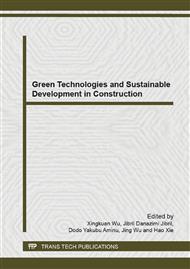[1]
Zhai, Z. & Previtali J. M. Ancient vernacular architecture: characteristics categorization and energy performance evaluation Energy and Buildings 42 (2010) 357–365.
DOI: 10.1016/j.enbuild.2009.10.002
Google Scholar
[2]
Edward, B. Rough guide to sustainability. London: RIBA Enterprises. (2007).
Google Scholar
[3]
Kandar, Z. M. Towards green buildings appreciations: a paper presented in the seminar series of the department of geoinfomatics Universiti Teknologi Malaysia, April 2010, UTM Malaysia. (2010).
Google Scholar
[4]
Langley. Changes in the Production of the Built Environment in Rural Areas. In African Environment, London, 2 (1976)37-51.
Google Scholar
[5]
Fathy, H. Natural energy and vernacular Architecture University of Chicago Press, 5801 Ellis Ave., 4th Fl., Chicago, IL 60637. (1986).
Google Scholar
[6]
Dodo, Y. A., Bashir, F. M., and Ogunsote, O. O. Stone as a Building Material For Sustainable Vernacular Architecture in North-Eastern Nigeria; WABER Book Chapter London(2011).
Google Scholar
[7]
Prucnal-Ogunsote, B. Reflection of Culture and Climate in the Vernacular and Modern Architecture of Akure. Federal University of Technology, Akure. 14-19 August, (2005).
Google Scholar
[8]
Denyer, S. African Traditional Architecture: an anthropological perspective. Heinemann, (1978).
Google Scholar
[9]
Oliver, P. (Ed. ) Encyclopedia of the Vernacular Architecture of the World, Cambridge University Press, New York, (1997).
Google Scholar
[10]
Dili, A.S. Naseer, M.A. Varghese T. Z. Passive environment control system of Kerala vernacular residential architecture for a comfortable indoor environment: A qualitative and quantitative analyses Energy and Buildings 42 (2010) 917–927.
DOI: 10.1016/j.enbuild.2010.01.002
Google Scholar
[11]
Koenigsberger, O. H., Ingersoll, T. G., Mayhew, A. and Szokolay, S. V. Manual of tropical Housing and Building-Climatic Design, Orient Longman Private Limited, ISBN: 978-81-7371-697-3 (1975).
Google Scholar


